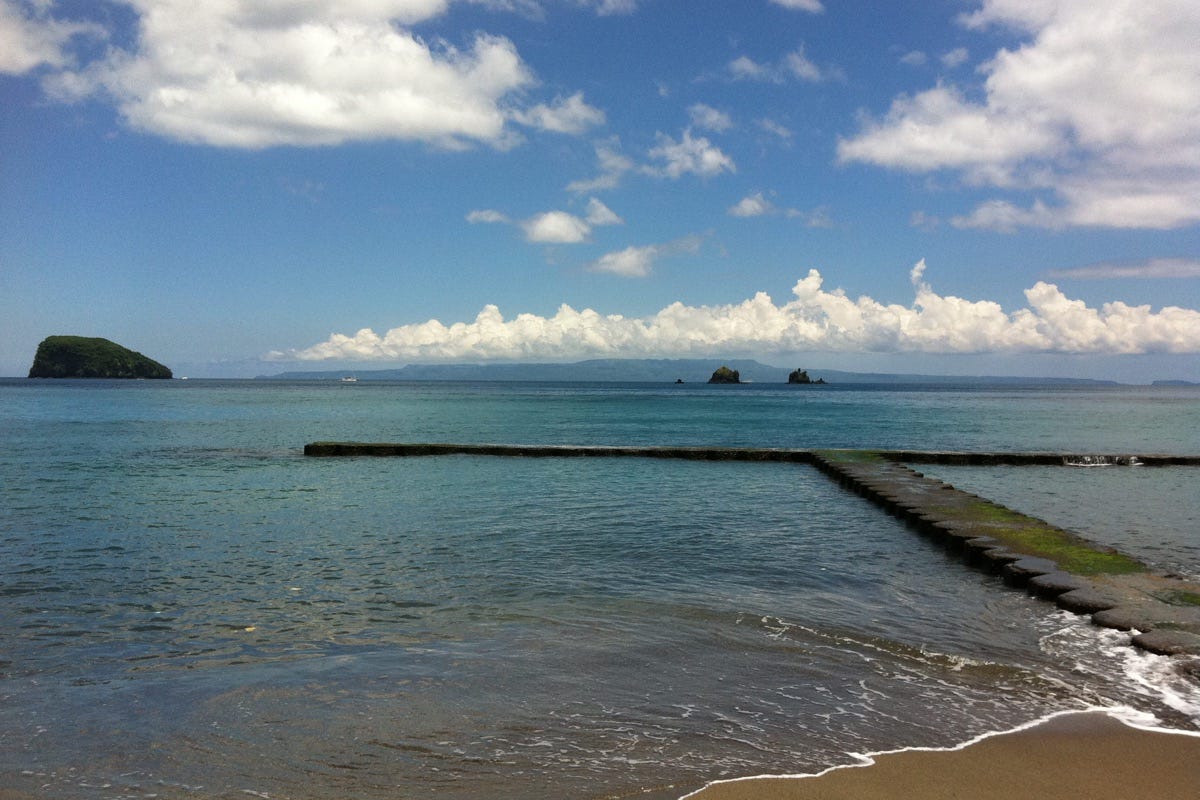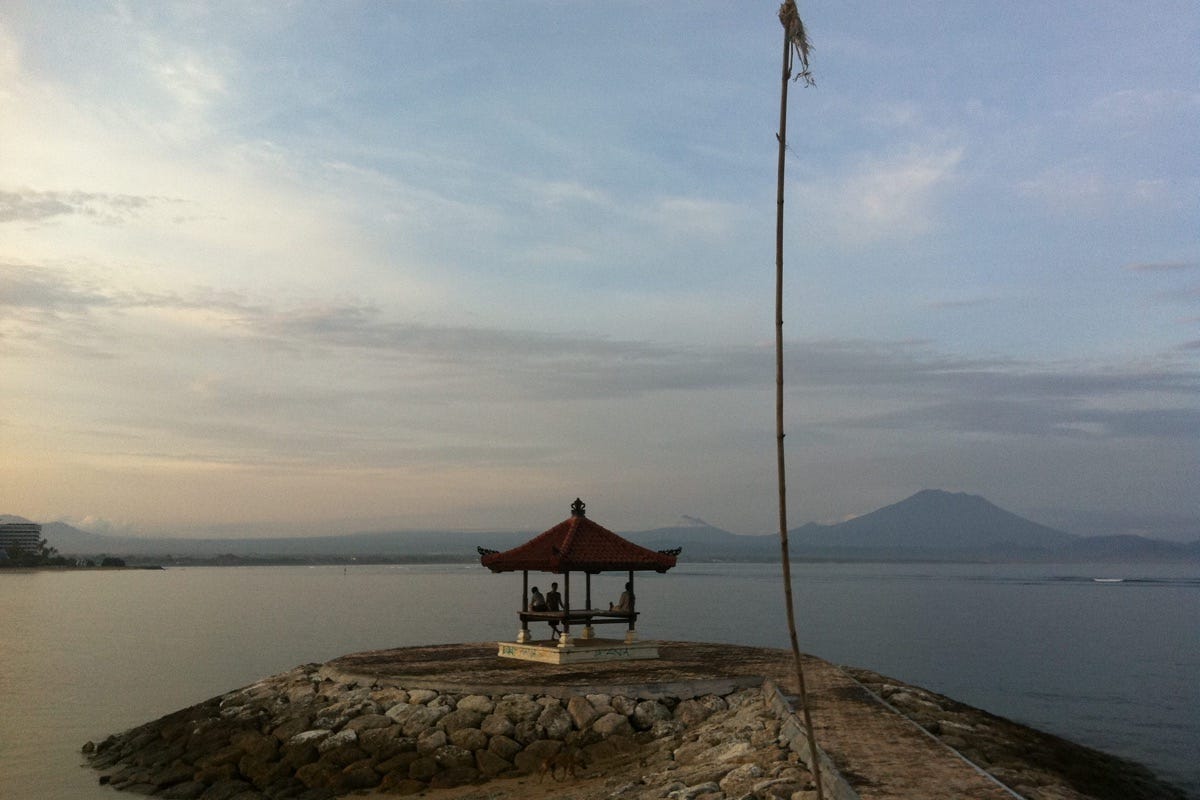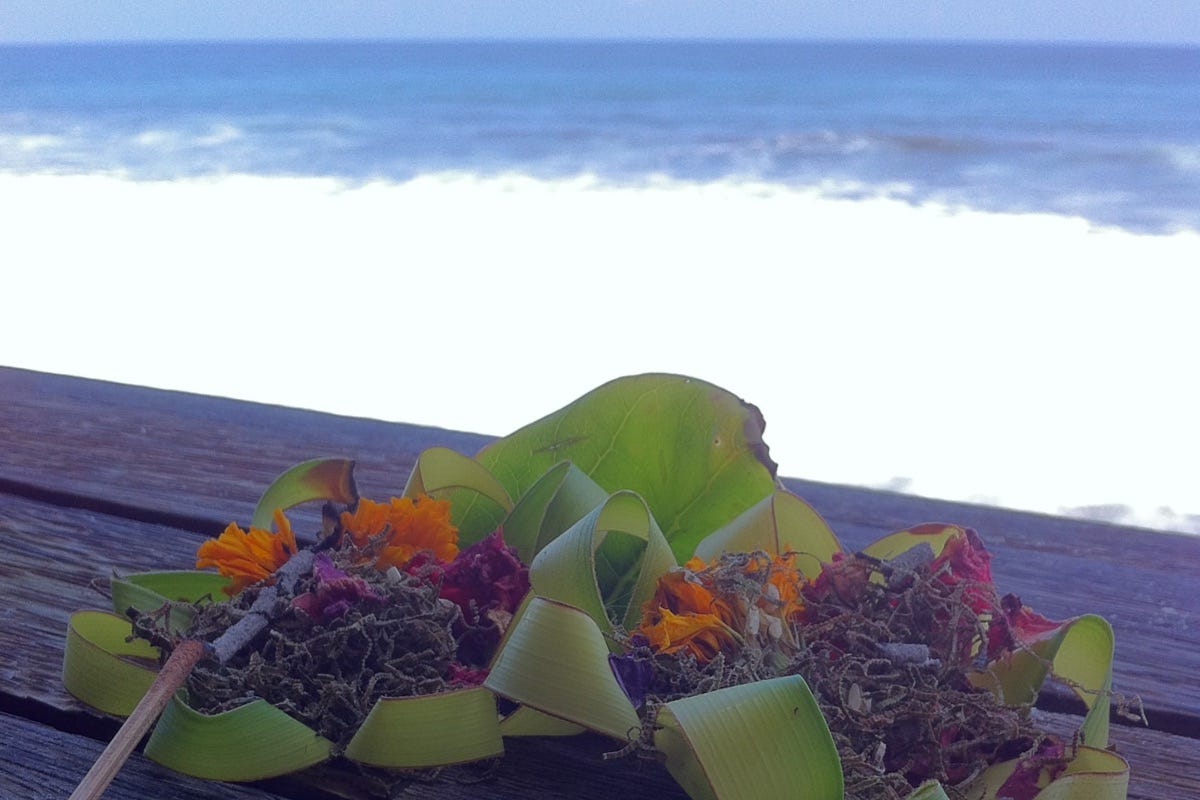A quick word of introduction. My name is Stuart McDonald and this is Couchfish—the perfect tub of ice-cream for the traveller stranded on the couch. The newsletter has both a paid edition which traces a fantasy itinerary through Southeast Asia, and a free one that covers, well, everything else. If you’d like to support me finding more tourism stuff to moan about, please consider becoming a paid subscriber. Thank you.
While it has resort in its name, the place we are staying at is more a private property with a couple of extra houses than a resort. Set right by the sea in a secluded area of Bali, down an un-signposted dirt trail, behind an un-signposted front gate, the effort involved in finding it makes it feel like a worthy prize.
Our accommodation comes in the form of a large two-floor wooden house. Airy bedrooms and cool-on-the-feet wooden floors are upstairs, while below, lazy chairs and fresh air beckon. Bags dropped, the kids make a beeline for the freeform pool by the sea, while we put our feet up. A grassy expanse runs almost to the ocean, where fast waves peel in, their foam rolling up onto a loose black pebble base. Roar rattle, roar rattle, roar rattle—the noise reverberates like a sack of marbles in my head, massaging by brain.
Time for a brain massage. Photo: Stuart McDonald.
Between the grass and the wave orchestra, pavers trace a curve around the property’s extremity, a small promontory of sorts. Beyond the pavers, enormous charcoal-coloured smooth boulders slope down to the water. With the afternoon sea breeze and a high tide, the spray rains into the pool—delighting the kids. The landscaper—not so much. When the waves later withdraw on the falling tide, I can see the bed of black sand the pebbles rattle over. The remnants of the original beach.
Bali is famous for its beaches, but like many things here, you need to work a bit to find the good ones. On our first few visits, hanging out in Seminyak and Sanur, we couldn’t understand what the big deal was. Sure there’s surf—a nice change from most of mainland Southeast Asia—but the strips of sand themselves, not so much.
Oh Nyang Nyang. Photo: Stuart McDonald.
It wasn’t until we got off our backsides and headed west—for the squid-ink black beaches that seem to stretch forever—or south to the Bukit, that we understood. The first time I saw Nyang Nyang from a Bukit cliff top I thought “holy crap, now that is a beach I could happily die on.” I should note this was back when there was nothing on Nyang Nyang, no road had disfigured the cliff, and no wrecked plane blighted the cliff-top. There’s a metaphor in that bloody plane I’m sure of it.
When we check in a staffer tells us the owner wants us to join him for dinner. They’d like to meet us, and have friends staying, so think it would be good for us all to meet and get to know one another. Drinks before sunset with dinner afterwards, we’re told.
The retaining wall protecting the manicured lawn from the surging waters of the Lombok Strait is far from an anomaly. Bali has decades of experience in losing its beaches. Candi Dasa, much of whose sand went awol after the innards of the reef were dug up to use the coral to make cement—ironically to build accommodation for tourists—is arguably the dumbest example, but it is far from the only one.
Sand way-station at Candi Dasa. Photo: Stuart McDonald.
Sanur Beach relies of Japanese-funded groynes to grab and hang onto what sand it can. This one I’ve been told was caused by dredging at Serangan for an ill-considered and profoundly stupid development plan, but I’ve never found any concrete coverage of it, so file that one under “A guy in a bar told me.” Regardless of the reason, Sanur’s once glorious beaches are long gone. Resort enclave Nusa Dua also relies on groynes, and the sickness continues around the south coast of the Bukit, where uber lux resorts have crucified surf breaks in trying to protect “their” beach.
The owner’s friends are also Bali residents, living elsewhere on the island over Ketewel to Kerambas way. Both wearing weathered tans and that somewhat withered premature ageing Southeast Asia living can deliver, they’re all about the good life. Fat consulting work for enormous environmental acronyms can be funny like that. Still, they’re far from corporates, and are great for ideas on where to go, as they seem to have been everywhere. Or, as they put it, everywhere that is still worth going to.
Making the best of a bad situation at Sanur. Photo: Stuart McDonald.
We gather at a long wooden table near the pool for drinks. Over small talk, I ask about the wall, what is the story? They say the property had once been beach-fronted, but, when erosion got out of control down the beach a ways, the powers that be said a wall needed to go in. The owner though, not liking how they’d done it down the beach, paid for the wall out of their own pocket. They wanted it “done right,” with its curving structure better withstanding the waves—in theory. Their main gripe is even with their fancy wall, the surfing suffered. Thank god for consulting gigs I guess.
The thing with retaining walls is while they may “fix” the problem out front, they tend to also shift it elsewhere. Sand has a habit of moving up and down the beach, and interrupt the natural process at your peril. Around Bali, more and more retaining walls are appearing, each with its own flow-on impact. As an example, I’m writing this from my beach shack in West Bali, and it forms a handy microcosm. My land certificate includes a metre and a half of land that no longer exists. Farmers tell me that decades ago, when the tide was out you could walk “forever” before reaching the water. Today, not so much.
Back in the day, doggo would have had far more real estate to run on. Photo: Stuart McDonald.
A river empties out about a kilometre to the west of me, and its banks inland were corralled by stone years ago. This protects the village from houses falling into the river I guess, but now when the rain comes, it overflows the walls instead, submerging whatever lies on the other side. Last year I was cut off from the highway for a day, as the road was so deep in floodwaters even I wouldn’t ride through it. Village residents having a choice between their houses being washed away or submerged seems like a rough deal. The river’s walls curve around onto the beach, but that section collapsed—perhaps our host building his own wall wasn’t so decadent after all.
Drinks and retaining walls done, with dinner being laid out we wander over to the table. As we sit, one of the owner’s friends raises his hands, asks for a pause, and gestures for us all to hold hands. I remember thinking oh no, are we praying? Jeez please God don’t ask me to say Grace.
Back at my shack out west, nearly all the land around it is farm land. The farmers rotate through rice, watermelon, corn, then give the land a rest before rinsing and repeating. The farmers want the wall at the river head fixed then extended all the way along the beach. Why? With a king tide, the Indian Ocean is sloshing about five metres from their fields, and they know that once salt water gets into those fields they’ll have a whole new world of problems they don’t need.
Arms stretched—the table is far bigger than our group—we all hold hands. When everyone else closes their eyes and dips their head, I do the same. I can’t hear anyone speaking, so not wanting to be the twit sitting there with head dipped and still holding hands long after everyone else has stopped, I concentrate on my hands. I figure, when I feel the grip loosen, it will all be over and I can start eating.
Years earlier, when I was living in Bangkok, a Thai friend dragged me along to see an “eastern man with electric hands.” Me, willing to try anything, went along. Sure enough, after much hocus-pocus—and a thousand baht—the man touched me, and he did have electricity running through his veins. My arm and leg kicked out involuntarily at his touch—and I left a convert. That was until a few months later, when the local press ran a story about the police chasing down an “electric monk.” It turned out he’d somehow connected himself to a car battery.
Eyes closed, the roar rattle, roar rattle, roar rattle comes back to the foreground of my mind. It’s amazing how much your other senses turn on when you turn one off. I listen to the percussion, I smell the food and the wine, I feel the sea breeze.
But then I feel something else. It’s like a tingling in my finger tips, and then, almost mad-monk-style, there is a clear and unmistakeable strong pulse of energy. It takes me so much by surprise that I open my eyes, but everyone’s hands are already falling as their heads rise. There’s a smile, nothing said, and we start to eat.
These won’t keep the sea at bay either. Photo: Stuart McDonald.
It is ... odd—and, need I say, there isn’t a car battery in sight. As nobody mentions what just happened, I don’t say anything either. The next day though, I see the owner, and I ask perhaps I was imagining things, but what was that last night?
The friend, they tell me, has a special energy they like to share.
Couchfish is 100 per cent independent and reader-supported. If you’re not already a subscriber, and you’d like to show your support, become a paying subscriber today for just US$7 per month—you can find out more about Couchfish here—or simply share this story with a friend.
Don’t forget, you can find the free podcasts on Apple, Pocket Casts and Spotify as well as right here on Couchfish.

















Share this post